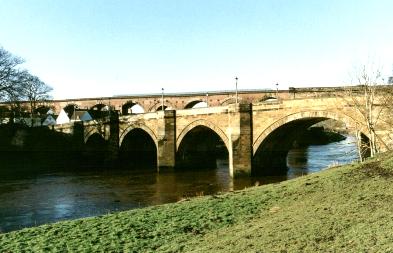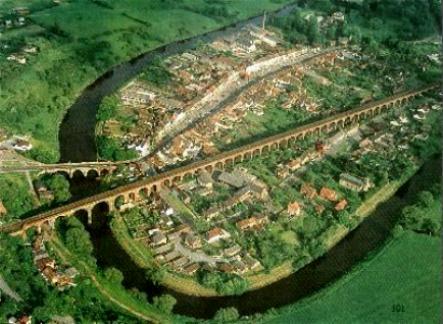
In 1206 Yarm was described as the second largest seaport in the North of England even though it was 15 miles from the sea. Ships up to 60 tonnes burden could reach it from the sea with the assistance of four tides and a favourable wind. For centuries Yarm was the site of the lowest bridge over the Tees. This was in existence in the early 13th century and was rebuilt by Bishop Skirlaw of Durham in 1400 AD. During the English Civil War part of the bridge was damaged and the missing section replaced, for security , with a draw bridge. It was the duty of the local vicar to raise the drawbridge each night and lower it the following morning. The upstream half of the two southernmost arches of the present bridge date from that time.
Our photo shows the downstream side of Yarm road bridge with the magnificent railway viaduct behind. (see also aerial photo). The main trade of the port was the export of corn, cheese, butter, salt, wool, hides and lead to London and the Continent. Imports included wine. Shipbuilding and sailmaking production also took place. The demise of Yarm as a significant port was signalled in 1771 when a bridge was built at Stockton (some 11 km / 7 miles downstream) severely restricting the size of vessels which could pass upstream. Stockton then became a much more important port than Yarm until the beginning of coal shipping at Port Darlington (near the embryo Middlesbrough). Middlesbrough Dock (close to which Middlesbrough’s Cellnet Riverside Stadium is built) was opened in 1842 to compete with upstream Port Darlington and closed for business in 1980 – it was just too small. Today most of the shipping activity on the river is based on Teesport and Tees Dock which offer deep water berths close to the North Sea.
This the end of the voyage up “our” part of the River Tees. I can find no more fitting illustration than this aerial photograph taken by the late Richard Crosthwaite. His family have been associated with the river for almost a century through the Tees Towing Company and were also patrons of the former Middlesbrough Amateur Boating Club. His hobbies included photography and microlight flying which he combined to produce a fascinating aerial archaeological record published as “Ancient Cleveland from the Air”. Tragically he was killed on a routine flight in May 1987.
The photograph, taken in the early 1980s, represents the Yarm that many will remember from the days when it was the venue for Tees Regatta. I still meet rowers who recall the “skinyard” and it’s smell.it’s roofs and chimney can be seen at the top of the picture. It has since been demolished and the site redeveloped with housing. Just to it’s right is the Friarage, now part of Yarm School but originally the home of Thomas Meynell, Chairman of the promoters of the Stockton and Darlington Railway. Their first meeting was on 12th February 1820 in the “George and Dragon” which still stands in the High Street. Also visible, near the Town Hall, is the Black Bull – their back room was used as the regatta changing room. Regatta teas were provided in the Hall attached to the Wesleyan Chapel, the octagonal building which can just be seen near the river if you go left from the Town Hall. This Chapel is said to have been one of Wesley’s favourites. The section of river in the top half of the picture is that which was used for the Regatta. Temporary landing stages and steps had to be uncovered each year by digging out the weeds and silt. Because at that time the river was tidal the regatta would begin with the course upstream towards the bridge with the rising tide. When the tide turned the direction of the course was reversed to be with the falling tide. As you may imagine it was sometimes a close run thing to complete all the races before we quite literally ran out of water.
The railway viaduct, which has 43 arches and is 695 metres long (regular quiz questions) was designed by Thomas Grainger and completed in 1851. The two arches which span the river are of stone, quarried in Osmotherley and hauled to Yarm by cart. The bricks for the other arches were also locally sourced, from two brickworks in Yarm. The viaduct is still in use today carrying freight and passenger services from Teesside down to the main east coast line which it joins at Northallerton. One of the long distance upstream “training outings” that we used to do was known as a “Yarm Sunday”. This would comprise choosing a Sunday when the flood tide at 11am at the boathouse had just over an hour to run. We would set off with the aim of reaching Yarm before the tide turned, park the boat on the river bank behind the Black Bull, adjourn for a little “light refreshment” and row back down to Stockton with the ebb tide. The river banks of Yarm have since seen significant changes. Flood defence walls have been created and an attractive promenade and jetty constructed. Yarm School Rowing Club have a landing stage on the Friarage river bank. You can take a river trip from Stockton to Yarm the hard way – by rowing or sculling. Or you can board the Teesside Princess and sample the delights of this section of the Tees with someone else doing the work. Whichever way you chose I hope this guide will add that extra bit of interest to your journey.
